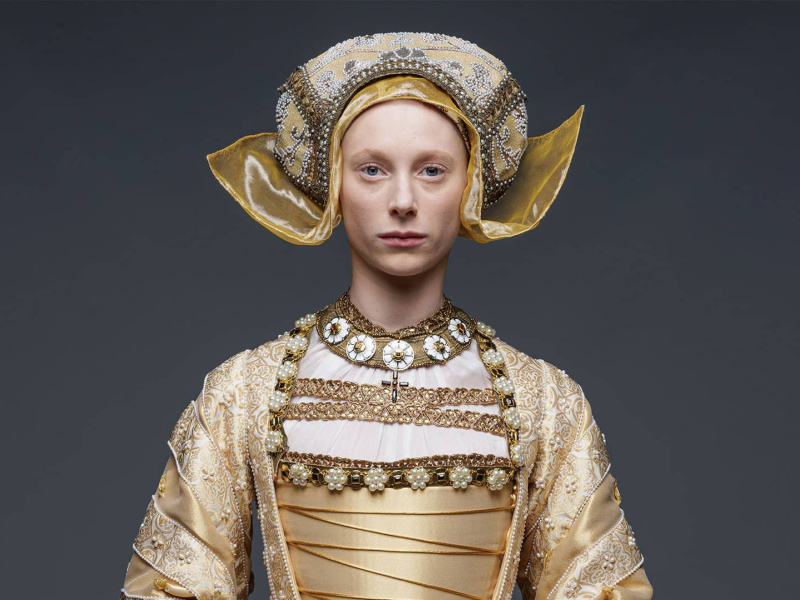– Protestantism, John Lambert,
and Anne of Cleves –
by Staff | PBS Masterpiece | April 16, 2025
With politics in disarray and another of Henry VIII’s wives tragically shuffling off her mortal coil in Episode 4 of Wolf Hall: The Mirror and the Light, Cromwell is tasked with finding a new wife…and a new alliance. But what are the religious issues affecting the politics, and where do the reformer John Lambert and the future queen, Anne of Cleves, fit in? We asked the production’s researcher, the author and Tudor historian Kirsten Claiden-Yardley, to help us make sense of the religious and political scene that drive the characters and the high-stakes drama in Episode 4.
Near the end of Episode 4, Cromwell urges Henry toward a marriage with Anne of Cleves, saying that her brother, Duke Wilhelm of Cleves, “…is not a Lutheran. Like yourself, he walks his own path, a guiding light to his people, Majesty.” To elucidate where Henry stood with regard to Protestantism, and how it panned out in his debate with John Lambert and his alliance with the German principalities, Claiden-Yardley explained, “The issues of Anne of Cleves and John Lambert are somewhat linked because it’s all to do with the question of “Where on earth is England going, religiously?” Now that Henry VIII is head of the Church of England, and he’s taking down the monasteries and cutting off funds to the papacy, he’s clearly not part of the Catholic Church headed by the Pope. But does that mean that England is now a Protestant country? It’s not quite that simple, because Henry actually is quite traditional in his religious beliefs. And that’s partly why this time period got so confusing and so dangerous.
“There were people like John Lambert, the theologian we see debating in Episode 4, with views that we now see as Protestant, but which were considered at the time radical ideas, a lot of it coming down to questions of the Eucharist and transubstantiation—is the communion wafer and wine actually Christ’s body and blood, or is it a representation of it? John Lambert espoused that it was just a representation. [He was later condemned for these views as a heretic and burned at the stake.] And particularly over in Europe, where you had all the big names of the European Protestant Reformation, your Luthers and Calvins, there were quite a lot of very radical Protestant ideas coming out. But Henry VIII did not favor that extreme level of Protestantism.
“So it was a period where people were simultaneously being rounded up and tried for being too Catholic and for being too Protestant. You had attacks on people in religious orders who were against the monastic dissolution, and who wanted to see a return to the Pope and the Catholic Church proper. And you saw attacks on people like John Lambert, who were too Protestant. And then in the middle were people like Thomas Cromwell and the Archbishop of Canterbury, Thomas Cranmer, who were in the political fray. Their personal tendencies leaned more towards reforming, but it was sometimes a bit hard to tell how far, because it was dangerous for them to ally themselves with this extreme reform [faction], regardless of what they thought—which can sometimes be hard to pick apart—because it was too far for the king.
“Henry VIII’s version of reform was very idiosyncratic. He wanted his divorce, and he wanted to reduce the Pope’s power, and he wanted the money and wealth that had been going to the Pope. So at times, he was open to more reform, and that’s when some of the Articles of Faith went out [establishing doctrine that was more reformed], and then a bit later those were rolled back, and they went more conservative again. And in the midst of this, Henry needed to find someone to marry again, so they were looking around at who would be a good fit.
“They looked at Christina of Denmark, they looked at Madame de Longville, who we probably know better as Marie de Guise, who married the king of Scotland. But they all had links with France and the Holy Roman Empire and were not necessarily too keen on Henry. But within the Holy Roman Empire—despite the Holy Roman Emperor generally favoring Catholicism—were the German states, the Swiss states, which were the core of the European Reformation, Luther and Calvin, that’s where it all really kicked off. So they were an option—they could ally with them and make a reforming Protestant.
“These individual states within the Holy Roman Empire had differing degrees [of reform] and were not always getting on. They disagreed with each other, they disagreed with the Holy Roman Emperor himself, and got into disputes, and he would try to take land off them or support a different claimant—it was very complex. But in the midst of it, there was the Duchy of Cleves, which had the advantage of not having gone hardcore Protestant in the way that some of the other German states did. It was a little bit more like Henry VIII in that they also did this slightly idiosyncratic reformation. So when they were looking around, they thought the Duchy of Cleves might be a bit more acceptable to Henry than trying to ally with an area, a ruler, who has gone full Protestant reformation in their principality. And they had someone, Anne of Cleves, that Henry could marry. It was a way to get that ally.”
Read the rest of the original article at PBS Masterpiece
